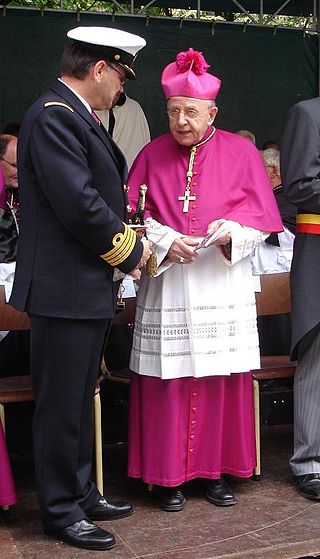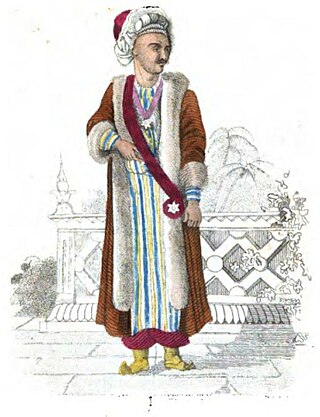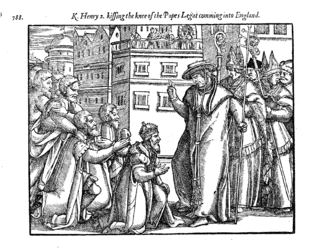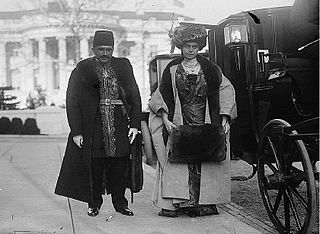Related Research Articles

A diplomatic mission or foreign mission is a group of people from a state or organization present in another state to represent the sending state or organization officially in the receiving or host state. In practice, the phrase usually denotes an embassy or high commission, which is the main office of a country's diplomatic representatives to another country; it is usually, but not necessarily, based in the receiving state's capital city. Consulates, on the other hand, are smaller diplomatic missions that are normally located in major cities of the receiving state. As well as being a diplomatic mission to the country in which it is situated, an embassy may also be a nonresident permanent mission to one or more other countries.

An apostolic nuncio is an ecclesiastical diplomat, serving as an envoy or a permanent diplomatic representative of the Holy See to a state or to an international organization. A nuncio is appointed by and represents the Holy See, and is the head of the diplomatic mission, called an apostolic nunciature, which is the equivalent of an embassy. The Holy See is legally distinct from the Vatican City or the Catholic Church. In modern times, a nuncio is usually an archbishop.

An ambassador is an official envoy, especially a high-ranking diplomat who represents a state and is usually accredited to another sovereign state or to an international organization as the resident representative of their own government or sovereign or appointed for a special and often temporary diplomatic assignment. The word is also used informally for people who are known, without national appointment, to represent certain professions, activities, and fields of endeavor, such as sales.

A diplomat is a person appointed by a state, intergovernmental, or nongovernmental institution to conduct diplomacy with one or more other states or international organizations.

A papal legate or apostolic legate is a personal representative of the Pope to foreign nations, to some other part of the Catholic Church, or representatives of the state or monarchy. He is empowered on matters of Catholic faith and for the settlement of ecclesiastical matters.

A legation was a diplomatic representative office of lower rank than an embassy. Where an embassy was headed by an ambassador, a legation was headed by a minister. Ambassadors outranked ministers and had precedence at official events. Legations were originally the most common form of diplomatic mission, but they fell out of favor after World War II and were upgraded to embassies.

A chargé d'affaires, plural chargés d'affaires, often shortened to chargé (French) and sometimes in colloquial English to charge-D, is a diplomat who serves as an embassy's chief of mission in the absence of the ambassador. The term is French for "charged with business", meaning they are responsible for the duties of an ambassador. Chargé is masculine in gender; the feminine form is chargée d'affaires.
Diplomatic rank is a system of professional and social rank used in the world of diplomacy and international relations. A diplomat's rank determines many ceremonial details, such as the order of precedence at official processions, table seatings at state dinners, the person to whom diplomatic credentials should be presented, and the title by which the diplomat should be addressed.
A permanent representative is a diplomat who is the head of a country's diplomatic mission to an international organisation.

Belgium–Japan relations are the bilateral relations between the nations of Belgium and Japan. Belgium has an embassy in Tokyo and five honorary consulates in Sapporo, Nagoya, Kyoto, Osaka, and Fukuoka. Japan has an embassy in Brussels.
The Austro-Hungarian Foreign Service was the diplomatic service carrying out the foreign policy of the Emperor of the Austro-Hungarian Empire from the formation of the Dual Monarchy in 1867 until it was dissolved in 1918.

Diplomacy comprises spoken or written communication by representatives of state, intergovernmental, or nongovernmental institutions intended to influence events in the international system.
The Diplomatic Service of the Republic of Lithuania is the part of the governmental service tasked with enforcing the foreign policy set by the President, the Parliament, and the Government of the Republic of Lithuania. The head of the service is the Foreign Minister.
The relations between the Ottoman Empire and the United States have a long history having its roots even before the American independence since there was a actually a running trade between these two regions. After the American independence in 1776, the first relations between these two countries started through the contact between the American merchants, statesmen and lastly the Navy and North African countries and with the Ottoman Empire after 1780.
References
- ↑ Boczek, Boleslaw (2005). "Diplomatic Agents: Heads of Permanent Missions". International Law: A Dictionary. Scarecrow Press. pp. 47–48. ISBN 9780810850781.
- 1 2 Berridge, G. R.; Lloyd, Lorna (2012). "Legation". The Palgrave Macmillan Dictionary of Diplomacy (3rd ed.). Palgrave Macmillan. p. 228. ISBN 9780230302990.
- ↑ "Hungary - Countries - Office of the Historian". history.state.gov. Retrieved 2016-12-06.